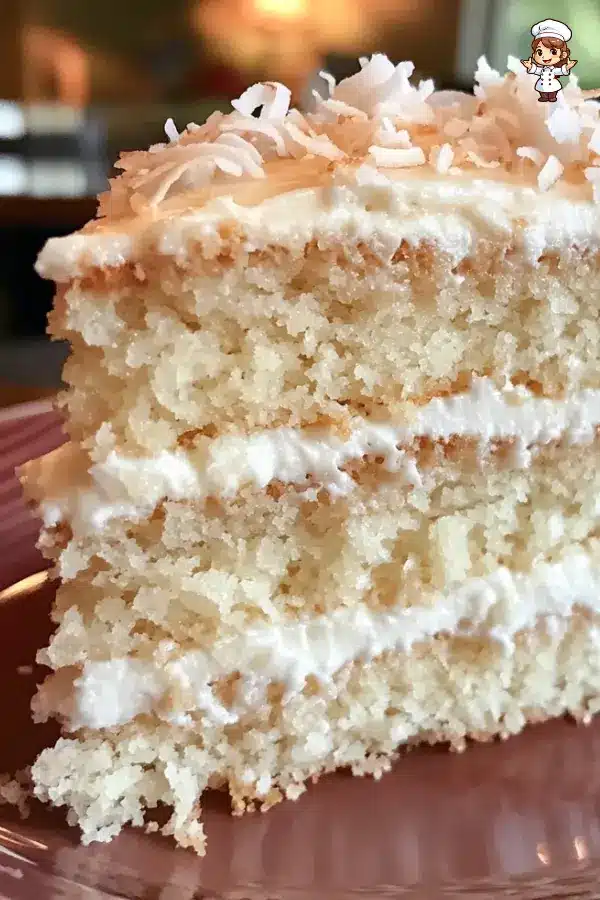If you’ve ever craved a cake that’s as light as air and bursting with rich, tropical flavours, then a coconut cake is exactly what you need. This decadent dessert is not only perfect for special occasions but also a treat that will win hearts at any gathering. Imagine layers of moist coconut cake bathed in luscious coconut cream cheese frosting, topped off with a generous sprinkle of sweet shredded coconut. It’s a dream come true for coconut lovers!
In this article, we’ll take you through everything you need to know to bake the perfect coconut cake from scratch. From understanding the ingredients that make this cake so special to providing detailed step-by-step instructions, we’ve got you covered. Plus, we’ll give you some tips on decorating, variations, and even some common FAQs so you can become a coconut cake pro!
Ingredients for the Perfect Coconut Cake

Essential Ingredients
To make the best coconut cake, the ingredients you use really matter. You’ll need a combination of wet and dry ingredients to get that light, fluffy texture and rich flavour that’s so characteristic of a coconut cake. Here are the essential ingredients that will bring your cake to life:
- Cake Flour: This is key to achieving a soft, airy cake. While you can use all-purpose flour, cake flour produces the lightest crumb.
- Baking Powder & Baking Soda: These help your cake rise and become fluffy.
- Unsalted Butter: Butter adds richness and flavour to the cake. Make sure it’s softened to room temperature for easy mixing.
- Granulated Sugar: This sweetens the cake and helps create that soft texture.
- Egg Whites: Using only egg whites will keep your cake lighter than using whole eggs, which tend to make cakes denser.
- Sour Cream: This is a secret ingredient for keeping your coconut cake moist and tender.
- Coconut Extract: This is a must for an intensified coconut flavour. While you can make the cake without it, coconut extract adds a deeper, richer coconut taste.
- Canned Coconut Milk: Don’t confuse this with the refrigerated coconut drink! The canned variety is thicker and creamier, providing a richer texture.
- Sweetened Shredded Coconut: Sweetened shredded coconut is a must for its signature coconut flavour and texture. It adds a little sweetness and chewiness to each bite.
Optional Add-ins for Customization
One of the best parts of making your own coconut cake is the ability to customize it. You could stir in some chopped chocolate for a decadent twist or add a bit of lemon zest to brighten up the flavour. If you want a little crunch, toasted coconut can be sprinkled inside or on top of the cake. Another fun variation is using coconut water instead of milk for a slightly lighter version or replacing some of the sugar with honey for a more natural sweetness. The possibilities are endless!
Step-by-Step Instructions for Coconut Cake

Prepping the Ingredients
The first step to baking a perfect coconut cake is prepping your ingredients. Start by preheating your oven to 350°F (177°C). While the oven heats up, grease your cake pans and line the bottoms with parchment paper. Greasing the pans ensures that the cake is released easily after baking.
Next, gather your dry ingredients. Whisk together the cake flour, baking powder, baking soda, and salt in a medium bowl. Set this aside, as you’ll mix it with the wet ingredients later.
In a separate bowl, beat the unsalted butter and sugar together with a mixer until the mixture is light and creamy. This step is crucial for getting a light texture in your coconut cake, so don’t rush it! Add the egg whites one at a time, ensuring that each is fully incorporated before adding the next. Then, add the sour cream, vanilla extract, and coconut extract. Mix well until everything is smooth and well combined.
Mixing and Baking the Cake
Now, it’s time to combine the wet and dry ingredients. Gradually add the dry mixture to the wet ingredients, alternating with the coconut milk. Beat the mixture at low speed to avoid flour flying everywhere, and continue until it is combined. Be careful not to overmix! Once the batter is ready, fold in the sweetened shredded coconut by hand. This will ensure an even distribution of coconut throughout the cake.
Divide the batter evenly between your prepared cake pans. You can use a kitchen scale to make sure they’re perfectly even. Bake the cakes for about 21-24 minutes, or until a toothpick inserted into the centre of the cake comes out clean. If your cakes are done, remove them from the oven and let them cool in the pans for about 10 minutes. After that, transfer them to a cooling rack to cool completely before frosting.
Frosting and Decorating Your Coconut Cake
The Perfect Coconut Frosting
No coconut cake is complete without the perfect frosting! For this recipe, we’re going with a creamy coconut cream cheese buttercream that pairs wonderfully with the cake’s light, fluffy texture. To make it, start by beating unsalted butter and cream cheese together until smooth and creamy. This mixture forms the base of your frosting, giving it that rich, tangy flavour.
Next, add in confectioners’ sugar gradually. It’s important to add it slowly to avoid creating a sugary mess, and this will help you achieve the right consistency. Mix in coconut milk, vanilla extract, and coconut extract to infuse that signature coconut flavour throughout the frosting. If the frosting is too thick, add a little more coconut milk; if it’s too thin, simply add more powdered sugar. Lastly, a pinch of salt balances the sweetness of the frosting perfectly.
Decoration Ideas for Your Coconut Cake
When it comes to decorating your coconut cake, less is definitely more. A simple, elegant look is often the best. After frosting the layers, you can generously sprinkle shredded coconut all over the top and sides of the cake. This not only adds texture but also creates that beautiful, snow-white finish.
For extra flair, consider toasting the coconut before applying it to the cake. This brings out a nutty, caramelized flavour that enhances the overall taste. If you want to get a bit creative, you could add edible flowers or a few sprigs of fresh mint for a pop of colour. Remember, the coconut cake itself is already a showstopper, so the decoration doesn’t need to be overly complicated to make an impact!
Variations of Coconut Cake
Gluten-Free Coconut Cake
For those who need a gluten-free option, making a gluten-free coconut cake is easy! Simply swap the regular cake flour for a gluten-free flour blend, and you’ll still get that moist and tender texture. You can also use almond flour for an even denser, nutty flavour if you prefer. If you use gluten-free flour, make sure it has a binder like xanthan gum to help the cake hold together.
If you want a lighter version, you can experiment with using coconut flour instead. Just keep in mind that coconut flour absorbs more liquid than regular flour, so you may need to adjust the liquid ingredients slightly.
Coconut Cupcakes or Sheet Cake
Turning this coconut dessert recipe into cupcakes or a sheet cake is a great way to serve a crowd. For coconut cupcakes, simply pour the batter into muffin tins lined with cupcake liners and bake for 18-20 minutes or until a toothpick comes out clean. This version is perfect for a party or special event, and they’re super easy to serve.
Alternatively, you could bake the cake as a sheet cake. Just pour the batter into a 9×13-inch pan and bake until golden and fully set. This is an excellent option for picnics or casual get-togethers.
For more delicious recipes, check out our Coconut Custard Pie Recipe!
Serving Suggestions and Pairings
Perfect Pairings with Coconut Cake
When it comes to pairing a coconut dessert with beverages, you’ll want something that complements the rich, tropical flavours without overpowering them. Coffee is always a safe bet. A strong cup of black coffee or a creamy latte pairs beautifully with the sweetness of the cake. The bitterness of coffee balances the coconut’s richness, making each bite even more satisfying.
If you’re hosting a gathering or celebration, try pairing your coconut cake with a glass of sweet iced tea or a refreshing lemonade. The tanginess of these drinks provides a nice contrast to the cake’s sweetness and adds a little zest to the overall flavour experience.
For those who prefer a more indulgent pairing, a mimosa or a Pina Colada cocktail can bring out the tropical elements of the cake, especially for summer events or holiday brunch. The coconut-flavoured drinks perfectly enhance the flavour profile, making them a match made in heaven.
When to Serve Coconut Cake
The best part about a coconut dessert is that it fits almost any occasion! It’s perfect for birthdays, holidays like Easter or Christmas, or even just a Sunday afternoon treat. The moist texture and fluffy coconut frosting make it ideal for special gatherings, but it’s also simple enough to make for a cozy, casual dessert. If you’re in need of a showstopper, this cake is guaranteed to impress your guests no matter the occasion.
FAQs About Coconut Cake
How Do I Store Leftover Coconut Cake?
If you have leftovers (which is rare but might happen!), it’s important to store your coconut cake properly to keep it fresh. The cake should be stored in an airtight container in the refrigerator to prevent it from drying out. The frosting can also soften over time, so make sure it’s well-covered. This cake will be kept in the fridge for about 3-4 days.
Can I Freeze Coconut Cake?
Yes! You can absolutely freeze your coconut cake. In fact, freezing it is a great way to preserve its freshness. Simply wrap the cake layers tightly in plastic wrap or foil, then place them in a freezer-safe bag. The cake can be frozen for up to 3 months. When you’re ready to serve it, allow it to thaw at room temperature for a few hours before frosting or serving.
How Can I Make Coconut Cake More Coconut-Flavored?
If you’re looking to amp up the coconut flavour in your coconut dessert, there are a few tricks you can try. First, use coconut milk (instead of regular milk or buttermilk) to enhance the flavour throughout the cake. You can also add extra coconut extract to the batter or frosting for an even bolder coconut taste. Another great idea is to mix some toasted coconut into the frosting for added texture and an extra coconut punch.
These simple tweaks will make your coconut cake even more irresistible!
Print
Coconut Cake Recipe
- Total Time: 54 minutes
- Yield: 12 slices 1x
- Diet: Vegetarian
Description
This Coconut Cake is a soft, moist, and fluffy dessert filled with the rich flavors of coconut and topped with a coconut cream cheese frosting. It’s the ultimate treat for coconut lovers, perfect for birthdays, holidays, or any occasion. The coconut cake is easy to make, and its tropical flavor is sure to impress anyone who tries it. Every bite is filled with the perfect balance of sweet, creamy coconut, making it the perfect dessert for your next gathering.
Ingredients
- 2 and 1/2 cups (285g) cake flour (spooned & leveled)
- 2 teaspoons baking powder
- 1/2 teaspoon baking soda
- 1 teaspoon salt
- 3/4 cup (12 Tbsp; 170g) unsalted butter, softened to room temperature
- 1 and 2/3 cups (330g) granulated sugar
- 5 large egg whites, at room temperature
- 1/2 cup (120g) sour cream, at room temperature
- 2 teaspoons pure vanilla extract
- 1 teaspoon coconut extract
- 1 cup (226g/240ml) unsweetened canned coconut milk, at room temperature
- 1 cup (80g) sweetened shredded coconut
- For the Coconut Cream Cheese Buttercream:
- 1 cup (16 Tbsp; 226g) unsalted butter, softened to room temperature
- 8 ounces (226g) full-fat brick cream cheese, softened to room temperature
- 5 cups (600g) confectioners’ sugar
- 2 Tablespoons (30ml) canned coconut milk
- 1/2 teaspoon pure vanilla extract
- 1/2 teaspoon coconut extract
- 1/8 teaspoon salt
- 2 cups (160g) sweetened shredded coconut
Instructions
- Preheat the oven to 350°F (177°C). Grease three 8-inch or 9-inch cake pans, line with parchment paper rounds, then grease the parchment paper.
- In a large bowl, whisk together the cake flour, baking powder, baking soda, and salt. Set aside.
- Using a stand or hand mixer, beat the butter and sugar together on medium-high speed until smooth and creamy, about 2 minutes.
- Beat in the egg whites, followed by sour cream, vanilla extract, and coconut extract.
- Slowly add the dry ingredients and coconut milk, mixing on low speed. Fold in shredded coconut by hand.
- Divide the batter evenly among the prepared pans and bake for 21-24 minutes or until a toothpick inserted into the center comes out clean.
- Allow the cakes to cool in the pans for 10 minutes, then remove and let cool completely on a rack before frosting.
- For the frosting, beat butter and cream cheese together, then add the powdered sugar, coconut milk, vanilla, coconut extract, and salt. Continue to mix until smooth and creamy.
- To assemble, spread frosting between cake layers, then cover the top and sides with frosting. Decorate with shredded coconut.
- Chill the cake for 20 minutes before slicing to help it hold its shape.
Latest Amazon Finds
Notes
- If you prefer a lighter version of this coconut cake, try using a lighter coconut milk and Greek yogurt instead of sour cream.
- To give the cake an extra coconut flavor, consider adding toasted coconut on top or mixing some into the frosting.
- The cake is even better the next day, as the flavors have time to meld together.
- Prep Time: 30 minutes
- Cook Time: 24 minutes
- Category: Dessert, Cake
- Method: Baking
- Cuisine: American
Nutrition
- Serving Size: 1 slice
- Calories: 450
- Sugar: 40g
- Sodium: 200mg
- Fat: 25g
- Saturated Fat: 15g
- Unsaturated Fat: 7g
- Trans Fat: 0g
- Carbohydrates: 52g
- Fiber: 2g
- Protein: 3g
- Cholesterol: 60mg
Keywords: Coconut Cake, Tropical Desserts, Coconut Layer Cake, Coconut Frosting, Cake Recipe



